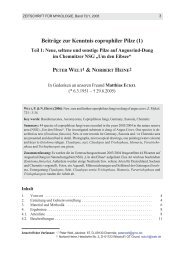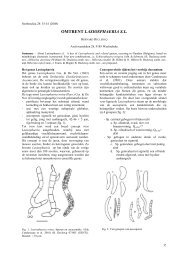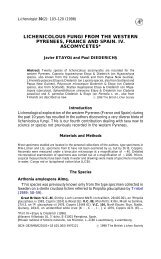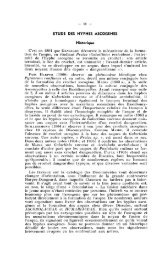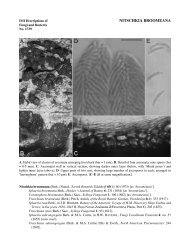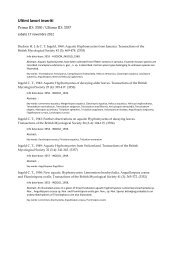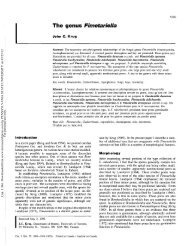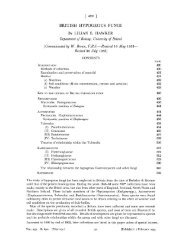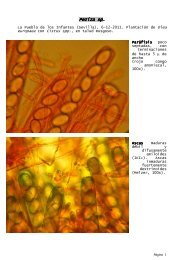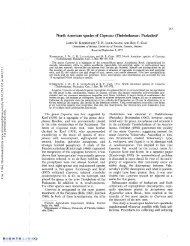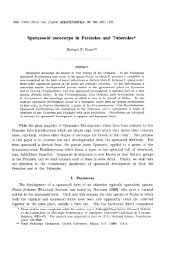The genus Pyrenopeziza Fuck. - ASCOfrance
The genus Pyrenopeziza Fuck. - ASCOfrance
The genus Pyrenopeziza Fuck. - ASCOfrance
Create successful ePaper yourself
Turn your PDF publications into a flip-book with our unique Google optimized e-Paper software.
FUNGUS [JAARG. 28 No. 1-4<br />
indicated a tribus of his <strong>genus</strong> Peziza. This tribus was raised to generic rank<br />
by P. A. Karsten (1871: IS), and two sections were distinguished, viz. "Sect. 1.<br />
Apothecia subiculo nullo vel minus distincto insidentia" and "Sect. n.<br />
Apothecia subiculo distincto subtomentoso insidentia Tapesia Fr. p.pr."<br />
Phillips (1887) regarded Mollisia sensu Fr. as a good <strong>genus</strong>, dividing it in the<br />
subgenera Niptera <strong>Fuck</strong>., <strong>Pyrenopeziza</strong> <strong>Fuck</strong>., Dilutella Phill., Mollisiella Phill.,<br />
Hysteropeziza Rabh., Pseudopeziza <strong>Fuck</strong>., and Peristomialis (without author's<br />
name). In part this scheme is based on the apothecial structure, e.g. Niptera<br />
being characterized by "texture rather firm; cups plane" and <strong>Pyrenopeziza</strong> by<br />
"texture soft; cups globose (mostly black) ," but on the whole the <strong>genus</strong> is very<br />
heterogeneous.<br />
Rehm (r896) recognized in his Mollisieae the group Eumollisieae with<br />
"Apothecien von Anfang an sitzend" and the Pyrenopezizeae characterized by<br />
"Apothecien zuerst in die oberen Zellschichten eingesenkt, durch dieselben<br />
hervorbrechend und dann sitzend." <strong>The</strong> Eumollisieae are split up into (a) genera<br />
without a subiculum, comprising Mollisia Fr., Niptera Fr., Belonidium Mont. &<br />
Dur., and Belonopsis Sacc., and (b) genera with a subiculum such as Tapesia<br />
Pers. and Trichobelonium Sacc. <strong>The</strong> Pyrenopezizeae comprise the Pseudopezizeae<br />
with the genera Pseudopeziza <strong>Fuck</strong>., and Fabraea Sacc., and the Eupyrenopezizeae<br />
with <strong>Pyrenopeziza</strong> <strong>Fuck</strong>., Pirottaea Sacc. & Speg., Beloniella Sacc.,<br />
and Velutaria <strong>Fuck</strong>.<br />
Boudier (r907) mentioned in his family Mollisiacees the following genera:<br />
<strong>Pyrenopeziza</strong> <strong>Fuck</strong>., Ephelina Sacc., Pirottaea Sacc., Coronellaria Karst.,<br />
Mollisia Fr., Tapesia Pers., Niptera Fr., Mollisiella Boud., and Spilopodia Boud.<br />
He characterized Mollisia as follows: "L'aspect general aplati, plus Hale, des<br />
receptacles qui sont toujours sessiles, ... " and <strong>Pyrenopeziza</strong>: "Les receptacles<br />
sont generalement noirs exterieurement avec la marge plus blanche." According<br />
to Boudier the paraphyses in M ollisia are filled with an oily protoplasm, lacking<br />
in <strong>Pyrenopeziza</strong>.<br />
In r9I2 Rehm revised the Pyrenopezizeae and the <strong>genus</strong> <strong>Pyrenopeziza</strong> was<br />
again discussed in detail.<br />
Nannfeldt (1932) recognized two subfamilies in his Mollisioideae, viz. the<br />
Mollisieae and the Pyrenopezizeae. <strong>The</strong> first category dealt with the species<br />
having the "Apothecien ganz oberfHichlich oder nur mit zapfen-formiger Basis<br />
im Substrat eingesenkt," those of the second group having the "Apothecien im<br />
Substrat eingesenkt, hervorbrechend." In the former are found the genera<br />
Haglundia Nannf., Belonium Sacc., Coronellaria Karst., Tapesia <strong>Fuck</strong>., Trichobelonium<br />
Rehm, Motlisia (Fr.) Karst., and Belonopsis Rehm; in the latter<br />
Pirottaea <strong>Fuck</strong>. and Hysteropezizella v. Hohn.<br />
<strong>The</strong> present author already demonstrated that it is hardly possible to delimit<br />
the <strong>genus</strong> <strong>Pyrenopeziza</strong> <strong>Fuck</strong>. from Mollisia (Fr.) Karst. merely on the basis of<br />
its erumpent behaviour during development. Nannfeldt occasionally arrived<br />
at the same conclusion (r932: 123,156), but probably maintained the separation<br />
for practical purposes. Gremmen (1954) united both genera, assuming Mollisia<br />
Fr. to be the correct name. It appears, however, that <strong>Pyrenopeziza</strong> <strong>Fuck</strong>. was<br />
published two years prior to Mollisia (Fr.) Karst., so the former takes precedence.<br />
Some corrections and additions to the diagnosis previously published<br />
appear necessary.



